- Photo Safaris
- Alaska Bears & Puffins World's best Alaskan Coastal Brown Bear photo experience. Small group size, idyllic location, deluxe lodging, and Puffins!
- Participant Guestbook & Testimonials Candid Feedback from our participants over the years from our photo safaris, tours and workshops. We don't think there is any better way to evaluate a possible trip or workshop than to find out what others thought.
- Custom Photo Tours, Safaris and Personal Instruction Over the years we've found that many of our clients & friends want to participate in one of our trips but the dates we've scheduled just don't work for them or they'd like a customized trip for their family or friends.
- Myanmar (Burma) Photo Tour Myanmar (Burma) Photo Tour December 2017 -- with Angkor Wat option
- Reviews Go hands-on
- Camera Reviews Hands-on with our favorite cameras
- Lens reviews Lenses tested
- Photo Accessories Reviews Reviews of useful Photo and Camera Accessories of interest to our readers
- Useful Tools & Gadgets Handy tools and gadgets we've found useful or essential in our work and want to share with you.
- What's In My Camera Bag The gear David Cardinal shoots with in the field and recommends, including bags and tools, and why
- Articles About photography
- Getting Started Some photography basics
- Travel photography lesson 1: Learning your camera Top skills you should learn before heading off on a trip
- Choosing a Colorspace Picking the right colorspace is essential for a proper workflow. We walk you through your options.
- Understanding Dynamic Range Understanding Dynamic Range
- Landscape Photography Tips from Yosemite Landscape Photography, It's All About Contrast
- Introduction to Shooting Raw Introduction to Raw Files and Raw Conversion by Dave Ryan
- Using Curves by Mike Russell Using Curves
- Copyright Registration Made Easy Copyright Registration Made Easy
- Guide to Image Resizing A Photographers' Guide to Image Resizing
- CCD Cleaning by Moose Peterson CCD Cleaning by Moose Peterson
- Profiling Your Printer Profiling Your Printer
- White Balance by Moose Peterson White Balance -- Are You RGB Savvy by Moose Peterson
- Photo Tips and Techniques Quick tips and pro tricks and techniques to rapidly improve your photography
- News Photo industry and related news and reviews from around the Internet, including from dpreview and CNET
- Getting Started Some photography basics
- Resources On the web
- My Camera Bag--What I Shoot With and Why The photo gear, travel equipment, clothing, bags and accessories that I shoot with and use and why.
- Datacolor Experts Blog Color gurus, including our own David Cardinal
- Amazon Affiliate Purchases made through this link help support our site and cost you absolutely nothing. Give it a try!
- Forums User to user
- Think Tank Photo Bags Intelligently designed photo bags that I love & rely on!
- Rent Lenses & Cameras Borrowlenses does a great job of providing timely services at a great price.
- Travel Insurance With the high cost of trips and possibility of medical issues abroad trip insurance is a must for peace of mind for overseas trips in particular.
- Moose Peterson's Site There isn't much that Moose doesn't know about nature and wildlife photography. You can't learn from anyone better.
- Journeys Unforgettable Africa Journeys Unforgettable -- Awesome African safari organizers. Let them know we sent you!
- Agoda International discounted hotel booking through Agoda
- Cardinal Photo Products on Zazzle A fun selection of great gift products made from a few of our favorite images.
- David Tobie's Gallery Innovative & creative art from the guy who knows more about color than nearly anyone else
- Galleries Our favorite images
Hands-on with the retro Nikon Df DSLR: Great fun in an awkward package
Hands-on with the retro Nikon Df DSLR: Great fun in an awkward package
Submitted by David Cardinal on Tue, 01/14/2014 - 10:45
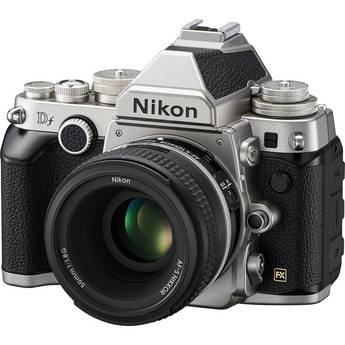 I’ve been shooting almost exclusively with the Nikon Df DSLR for the last month. When I crouch behind the retro-styled body and snap off shots that will be captured on the excellent D4 sensor, I feel like it could be the ultimate street photography camera. It is quick enough (5.5 fps), has world-class image quality, and is about half the size and weight of a Nikon D4. Besides, I figure it looks cool, and I certainly get some odd glances as if to say “is that a film camera you’re using?” My euphoria lasts until I need to change a setting. That’s where the retro design gets in the way. Read on and I’ll help you decide if the Nikon Df needs to be in your camera bag or in your collection…
I’ve been shooting almost exclusively with the Nikon Df DSLR for the last month. When I crouch behind the retro-styled body and snap off shots that will be captured on the excellent D4 sensor, I feel like it could be the ultimate street photography camera. It is quick enough (5.5 fps), has world-class image quality, and is about half the size and weight of a Nikon D4. Besides, I figure it looks cool, and I certainly get some odd glances as if to say “is that a film camera you’re using?” My euphoria lasts until I need to change a setting. That’s where the retro design gets in the way. Read on and I’ll help you decide if the Nikon Df needs to be in your camera bag or in your collection…
Image Quality
As befits a camera modeled after the classic photojournalist models, the Nikon Df aims for low-light image capture more than pixel count. The sensor is borrowed from the low-light-champion Nikon D4, providing it with 16 million large, bright pixels. Unfortunately, with excellent pro-quality 24MP and 36MP cameras like the Nikon D800 and Nikon D610 available for the same or lower cost, the Df isn’t likely to be the camera of choice for landscape or portrait photographers.
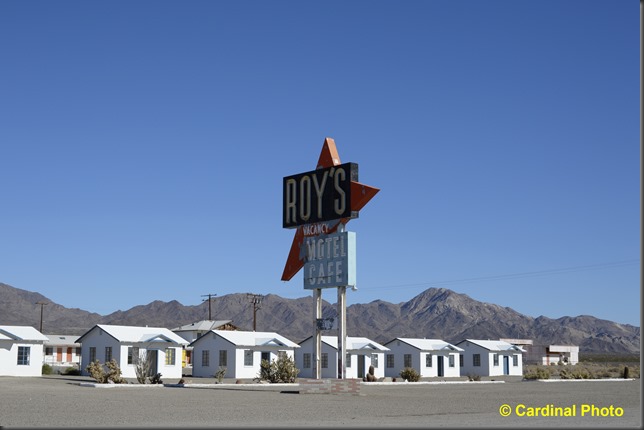
Using a retro-styled camera to photograph a historic motel on Rt. 66 seemed appropriate.
Fortunately the wide-open spaces let me back up to get the framing I wanted.
Nikon Df, Nikon 50mm f/1.8 lens, f/16 @ 1/500s ISO 400.
Size and Handling
I love having a Nikon D4 sensor in the relatively small, light Nikon Df body. It is much easier to maneuver than its larger cousin, and less conspicuous for street photographers. All that is great, until you need to fiddle with the controls. As part of the “retro” design, Nikon has made many of them replicas of the dials on top of its old F-series film cameras. Unfortunately, digital demands different control systems than film. For example, the ISO setting is on a large ring with locking button. For film, where the ISO is seldom changed, that wouldn’t matter. But for digital, where the ISO could change nearly shot to shot, the retro version is much harder to change than in Nikon’s other pro DSLRs where there is a dedicated ISO button on top of the camera that can be used with the command dial.
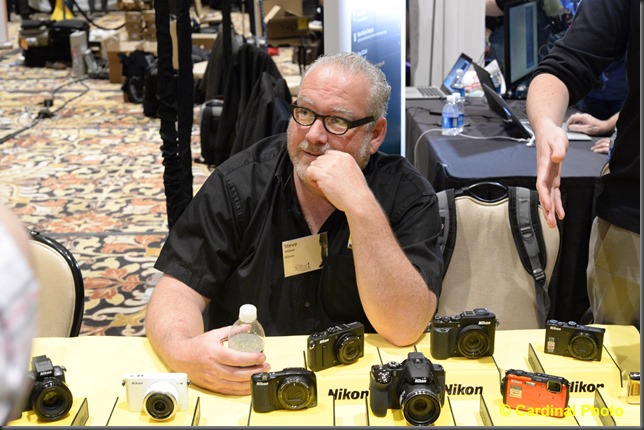
The huge D4 sensor makes indoor shooting a breeze even without flash.
This is a straight from the camera of Nikon’s Steve Heiner at CES.
Nikon Df, Nikon 50mm f/1.8 lens, f/7.1 @ 1/50s, ISO 5000.
Similarly, Exposure Compensation is moved to a dial on top with a locking button. This is slower than regular Exposure Compensation and much slower than having Easy Exposure Compensation set on other models. Shutter speed is also set on top of the camera, although in Aperture mode the entire, large shutter speed dial is completely ignored – wasting space on top of the camera that would normally be used for additional shooting data.
Price
Okay, by now some of you are probably thinking that I’m a real whiner for criticizing a retro camera for being, well, retro. Fair enough. If the Nikon Df was priced as a fun camera, at under $1000, I’d cut it a lot more slack. At $2,750 for just the body, it moves into a different realm. In order to be more than just a collectors’ item for well-heeled Nikonphiles, it needs to be good enough to be a working camera for someone. On that score, I don’t think it makes it. A D800 style body with the D4 sensor would be much more effective for that task.
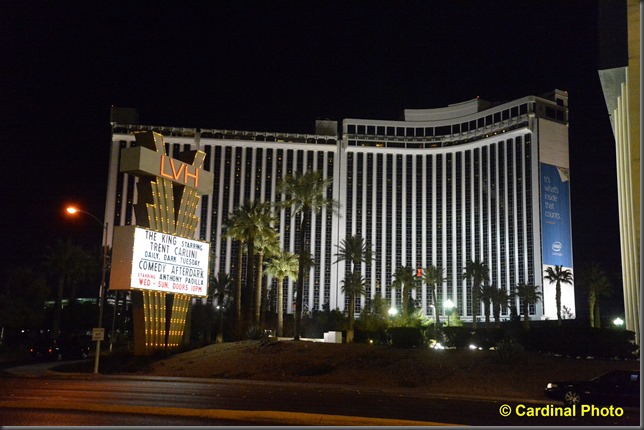
Hand-held night shots, even with motion, are also pretty simple with the Nikon Df.
This image of the LVH in Vegas was shot at amazing ISO 25,600 to freeze the sign.
Nikon Df, Nikon 24-85mm Lens @ 40mm, f/4.2 @ 1/500s, ISO 25600.
Should you buy one?
If you want a fun experience that allows you to relive your early days as a photographer, the Nikon Df is a lot of fun. Of all the devices I’ve used in the field over the last year only Google’s Glass has generated more curiousity. You’ll have to decide if your fun budget can stomach $2750. If you are looking for a lighter, smaller version of the Nikon D4, you have a tough decision. On image quality, it delivers, but the awkward controls will likely prove frustrating.
If you do decide to buy one, consider the bundle with the also new “retro” design Nikon 50mm f/1.8 Lens for $3,000. I did most of my Df shooting with the new 50mm, and loved its small size, quick focus, and razor sharp images. However if you are in tight spots a lot (like the show floor at CES), then the new Nikon 35mm f/1.8 Lens might be a better bet.
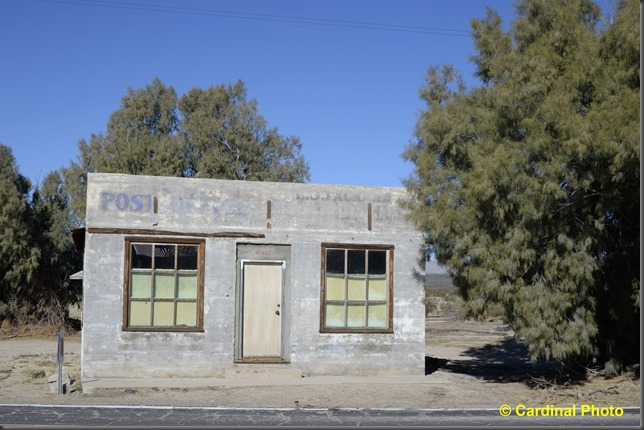
The old Post Office at Kelso in the Mojave Desert has always intrigued me.
Nikon Df, Nikon 50mm f/1.8 Lens, f/16 @ 1/500s, ISO 400

